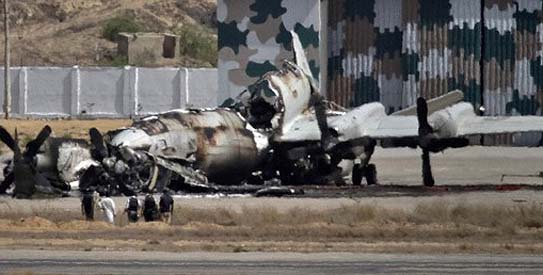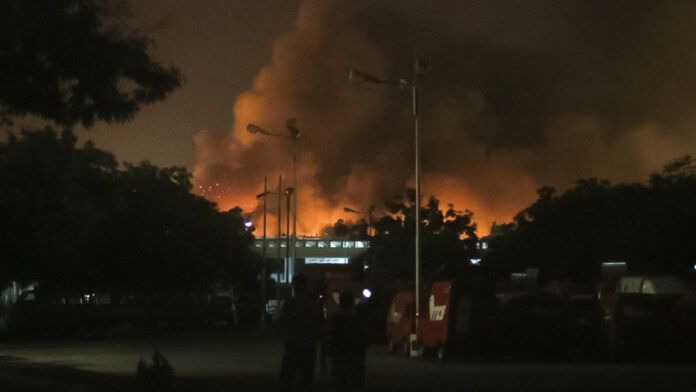Dear Readers,
Karachi, once known as the “City of Lights” now reels under the sway of criminal and terrorist elements. Darkness has settled over this city, literally and figuratively — load shedding for hours on end has given rise to untold miseries, affecting economic and commercial activities while acts of terrorism now occur almost daily. Common street crimes have grown so much that 7 out of every ten people are victims of such crimes. Karachi that generates more than 50 percent of the nation’s revenue is now under depression with the many protests, hartals, dharnas, clashes, etc that erupt on every given occasion causing stoppage of all business activities adding to the economic crisis. Target killings have become so common in Karachi that the daily killing of five or six people does not appear to move people as it did once. Despite the many claims of the government target killings have gone on unabated and even today, on an average, six to seven people are eliminated daily. Only a fleeting look at the city’s security situation and the incidents of crime reveal the severity and seriousness Of the issue.
The terrorist assault on Karachi’s old airport, Jinnah International Airport (used for VIP flights and cargo) on Sunday, 7th June by the Tehreek-e-Taliban Pakistan (TTP) lasted for six hours, leaving at least 36 people dead including the assailants. This is an indication of how sophisticated the Taliban have become. Even as flights resumed the next day, the Taliban struck again with gunmen on motorbikes opening fire on an ASF academy adiacent to the Old Karachi airport; thankfully there were no casualties.
Unfortunately, the many successive governments failed to play their due roles for securing the lives and properties of citizens. Had some difficult decisions been taken earlier the situation might have been different today. For the benefit Of readers I am reproducing my article “AVERTING APOCALYPSE”
Two well-armed groups of militants penetrated separate entry points at Jinnah International Airport Karachi at around 11 pm on Sunday night, killing 5 ASF personnel in the process. Nineteen good men, 11 belonging to ASF, laid down their lives to save the honour (and future prosperity) of this nation. Charred bodies of 7 workers were recovered from a cold storage facility 26 hours later. Many seriously injured are still in critical condition. Alerted by the firing, ASF men at their posts on the tarmac forced the militants to take cover in a relatively deserted part (at that time) of the airport (Shaheen, Ispahani and Gerry Hangars). Given crucial time and space, ASF’s Quick Response Force (QRF) reacted well to contain the militant’s intent and capacity for death and destruction.
Their terrorists’ weapons, ammunition and food packs suggested the target was to either hijack one or more aircraft full of passengers or blow some up at Terminal 3. Had our ASF heroes faltered, the damage would have been immense, exceeding that of the Tamil Tigers attack on Colombo International Airport on July 4, 1983, destroying 8 Sri Lankan military aircrafts and damaging 18 more, with cost estimated at US$350 million.
Rangers and Police reinforcements reached the airport very quickly and the police set up roadblocks. Assuming command and control, DG Rangers Maj Gen Rizwan Akhtar must be commended for quickly reinforcing the ASF elements and engaging the militants with Rangers. An Army unit from Malir Cantonment mounted on Armoured Personnel Carriers (APCs) set up a protective cordon a couple of hours later, allowing those already engaged in battle to finish the job. They were later joined by SSG’s Zarrar Company. With so many different outfits operating at night, how does one separate friend from foe? It is a miracle no one got killed by “friendly fire”. This has to be rationalised for the future, the obvious suggestion is to drastically beef up the ASF’s QRF. Taking the brunt of casualties, the ASF and Rangers did a magnificent job in eliminating the militants. Looking like Uzbeks, 7 militants were killed, 3 blew themselves up.
The electronic media’s enthusiasm to show live TV feed was dangerous, inadvertently giving away the strength and positioning of our forces. The police blockade should keep them further away, and no interview should be allowed while the fighting is going on. Only formal briefings by a duly appointed spokesman. The midday firing emanating from Pehlwan Goth adjacent to the ASF Camp at Karachi Airport on Tuesday set off alarm bells (and rumours galore thereof) because the TV channels screamed to high heaven about another “terrorist attack” on the airport. The channels must not run amok in their effort to get more TV viewer mileage; they need to be more responsible.
The print media tends to be even worse, a “holier than thou” hypocrite pontificated about the agencies “not doing their job”, conveniently forgetting that he and his ilk have been railing against the Army and ISI on what is clearly an external agenda, forcing them to defend themselves rather than concentrate on their job. At the macro-level what is needed, other than cooperation between intelligences agencies and settling up of a Counterterrorism Force (CTF), is de-weaponisation of Karachi, de-politicising the LEAs and giving them more powers for “search and secure” operations. Without making the local bodies functional, ferreting out militant hideouts will otherwise be almost impossible because of massive ill-planned urbanisation of Karachi.

After the Mehran incident in 2011 the ISI were tasked with checking the vulnerabilities of strategic installations in Karachi and other cities. A complete video presentation (alongwith others) on dozens of such spots at the Karachi Airport was made to the then Corps Comd Karachi, Lt Gen Zaheerul Islam (now DG ISI), who shared it with the Ministry of Defence for immediate implementation. Unfortunately, CAA had other priorities and except for raising the perimeter fence at a few places, they simply sat on the observations/recommendations.
The Civil Aviation Authority (CAA) must also follow the practices prevailing in the world and drastically reduce the number of airport entry passes. Country-wide 26,000 passes are issued for the functionaries working at the airport; parliamentarians, ministers, etc need 2,300 VIP passes, the commercial shops within the airport are issued 1,500, not counting the 750 passes for Corporate VIPs. When I suggested to the DG CAA, Air Marshal (retd) Mohammad Yusuf, that other than the functionaries (which could be reduced) most other passes could be replaced by a few professional protocol companies, as is the common practice in the world, he gave me a contemptuous look. With his job depending upon satisfying VIPs, what does one expect from a consummate bureaucrat heading what essentially must be a commercial entity?
Landing at Faisal Airbase at about 4 am Monday morning, Capt Shujaat Azeem and the Civil Aviation personnel fast-tracked, making the airport operational in 12 hours from the time the firing stopped at 4:00 am. They deserve being commended. Shedding crocodile tears for those who gave up their lives, those responsible for the blunders and our deficiencies that led to this near disaster are sitting in generator-run air-conditioned offices, basking in the glory earned by our heroes, they must be taken to task. Pakistan has been spared both a major disaster and an unending embarrassment. Shujaat Azeem needs to clean up his house, starting with the “mafia” entrenched in the Aviation Division and the Civil Aviation Authority (CAA). Having met the DG CAA only once, one can only comment that the gentlemen should be sent out to pasture sooner rather than later. Get someone competent!
What has been done to overturn the ban on recruitment in the ASF? Short by 600 personnel, they cannot fully man even the existing posts. With the ASF badly needing state-of-the-art equipment and technology, has the DG CAA made any noises except give lip-service to the desperate ASF request for replenishment of their critical deficiencies of both personnel and equipment for years? They are short of searchlights, sensors, explosive detection equipment, cargo scanners, communications equipment, metal detectors, infrared devices, night vision goggles, CCTVs, bullet proof helmets and jackets, vehicles, Armoured Personnel Carriers (APCs), etc. The ministry of defence had a few years earlier made a strong case to the ministry of finance but the Babus shot down the Rs3 billion request. What if an aircraft full of passengers and fuel on the tarmac and costing many billions of rupees caught fire? Could we afford the cost of that collateral damage to our aviation industry? With our airports at the cutting edge of “Foreign Direct Investment” (FDI), what will any investor do if the common perception is that our points of entry are not safe and secure?
All airports in the world are vulnerable and difficult to protect. One expected a blowback from the TTP; there may be more. Surprise is always with the attacker, but useful and actionable intelligence must stop him before he steps out of his base on his mission. A full-blown catastrophe has only been averted because of the bravery of our ASF personnel. Ch Nisar is one of the capable colleagues of Mian Nawaz Sharif. Having talked the good talk about the dire necessity for a CTF for almost a year, he must now deliver before another apocalypse hits us.




